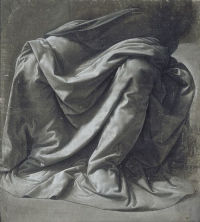Remaking Nature Click on the thumbnails to explore the trail
Read more about this trail (expand)
Leonardo’s ultimate aim was to imitate nature by remaking nature, as opposed to slavishly copying natural forms. This would require a profound understanding of the relationship between the effects of natural appearances and the underlying causes that gave rise to their form. Equipped with this knowledge, Leonardo believed he could create forms equitable to those found in nature, many of which might be of great service to man.

- Enlarge
- Zoom & explore
- Photo RMN - © Jean-Gilles Berizzi
Drapery study for a seated figure Late 1470s
According to Vasari, Leonardo made clay figures which he covered with a soft linen dipped in wet clay. Using black and white pigment applied with the point of a brush he would execute studies such as this on fine linen with “great patience”. Strictly speaking, this is not a preparatory study, but an exercise in modelling in light and shade. In its sculptural effect, Leonardo has achieved a timeless perfection that remains unsurpassed to this day.
Realising the importance of light and shade in painting, Leonardo planned to write a treatise on the subject, and outlined its proposed contents in his notes. Amongst other issues it would deal with the categorisation of shadows, an examination of their effects on colour and the effects of the colour on shadows. It would also examine how shadows are conditioned by distance from a given light source.
Given the unimaginable complexities of the subject it is not surprising that Leonardo never did complete the treatise. Nonetheless, he continued to observe light in nature throughout his lifetime and filled hundreds of pages of his notebooks with experiments and observations on the subject.In
Leonardo's words
Shadows appear to me to be of supreme importance in perspective, because without them opaque and solid bodies will be ill-defined; that which is contained within their outlines and their boundaries themselves will be ill understood unless they are shown against a background of a different tone from themselves.
Studies of draperies of this type were executed in the Verrocchio workshop as a sort of training exercise in which the artist learnt how to model sculptural forms in two dimensions.
According to Giorgio Vasari in his biography of Leonardo, the artist was skilled at this type of drawing, for which he sometimes made “models of clay figures, which he covered with soft rags dipped in plaster and then patiently copied them upon fine cambric or used linen, working in black and white with the point of a brush – marvellous things.”
This drawing is similar to the draperies of the Virgin in the Annunciation, although not exactly the same. It is likely that Leonardo kept such drawings in his portfolio so that they could be used as points of reference in paintings as and when the opportunity arose, and as examples for apprentices.
- Medium Brush and grey tempera, highlighted with white on grey prepared linen
- Size 26.6 x 23.3 cm
- Location Musée du Louvre











